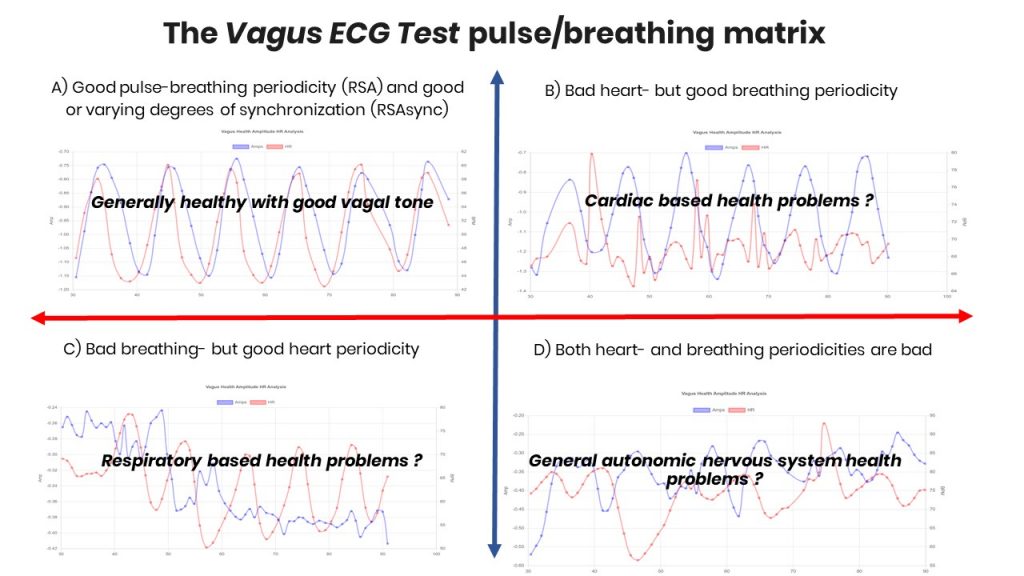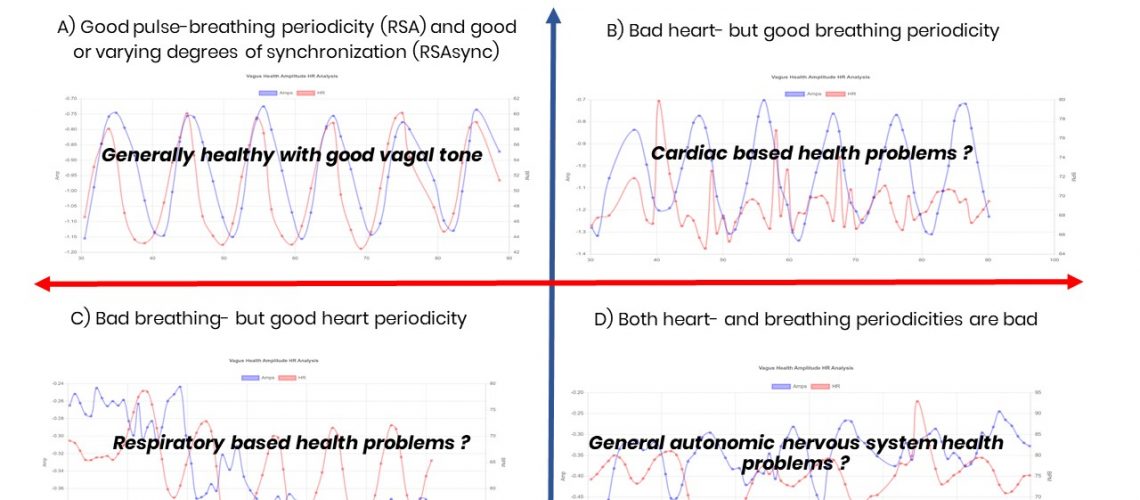Summary: The ‘Vagus ECG Test‘ results can be divided into 4 general groups according to a ‘Pulse/Breathing Vagus Matrix’ classification:

Group A) The majority of our users have a good Respiratory Sinus Arrythmia (RSA in average above 80), whereby the pulse and breathing have same periodicity during controlled breathing. Users though have surprisingly much variation in the time-synchronizations (RSAsync < 80). This can be explained by a variation of factors such as blood pressure, medical interventions, chronic disease or genetics. We need further research to understand more about these rather big differences between our users. A RSAsync value less than 80 is not in itself a ‘bad’ result but we recommend to do further testing and self-discovery to understand whether this ‘out of synchronization’ is temporary or a more permanent state of the autonomic nervous system.
Group B) In this group there is often some kind of cardiac irregularity which is distinguishable as a ‘not so smooth’ pulse curve. There might be some degree of periodicity to breathing but the pulse curve is usually not well synchronized with the smooth breathing curve and it is visually not ‘smooth’ as in Group A). Some users have later confirmed having an ongoing disease or cardiac health issues. Other users can get this kind of test pattern from high stress situations or excess drug- and alcohol consumption.
Group C) In this group there is surprisingly low periodicity in the breathing amplitude graph. The heart curve often has smooth variations according to the 5 sec inhale and 5 sec exhale controlled breathing instructions. Therefore, we can conclude that the user has been doing – as instructed – paced breathing but due to some reason this breathing is not expressed as in the normal curves in Group A). We suspect that respiratory issues, low grade local inflammations or long-term autonomic nervous system issues can cause this effect. In some cases we also have noticed that attention deficit can causing such lack of autonomic control of breathing and results fall within this group.
Group D) This type of results can be caused by a number of different reasons. The most usual are severe stress, general autonomic nervous system imbalances, heavily burdened immune system or damage to the autonomic nervous system from for instance PTSD. If the test results are for several days consistently in the ‘Group D’ – after having been in Group A – users often later confirm having been in a state of strong stress or having fallen ill.
Conclusion: The graphical representation in the Vagus ECG Test for breathing and pulse synchronization (the central HEART/BREATH button on the Vagus Watch Apps) is the most valuable tool for interpretating of the Vagus ECG Test. It shows how the heart and breathing are synchronizing during the 5 seconds inhale and 5 seconds exhale control breathing which is done during the second (60sec) part of the test. It is visually easy to notice if the test person cannot create ‘calm’ waves for both the heart rate and breathing. If the test person cannot ‘create’ this very important physiological reaction through breathing, then there probably are some negative health issues influencing the heart, lungs or autonomic nervous system. These health issues vary between users. We therefore find it very important to for the users to accumulate a sufficient number of tests to be able to monitor individual changes and detect ‘personalized patterns’.
The Vagus ECG Test results are for health monitoring only. The Vagus ECG smartwatch is not a medical device. Its analysis should not be used as medical diagnostics. The users should always seek professional medical advice before altering any medical treatment, regimens or medication. We recommend visiting a medical professional if the test results are changing from matrix area A to matrix areas B, C or D and this change is persistent over several days during more than eight tests. This recommendation is naturally valid only if the user cannot find any other natural explanation for the changes. The Vagus ECG test and the Vagus ECG watch are not medical- devices or diagnostics methods and they should not be used to alter medical- or other types of similar treatments or medications. The here stated and hypothesized health statements are based on case-experiences from test persons using the Vagus ECG watch. The conclusions are general and may not be valid for other test persons. The Vagus ECG Test is developed by Gustaf Kranck and Vagus Health Ltd. in Cambridge, UK and is patent pending.

